The forgotten art of playing spin
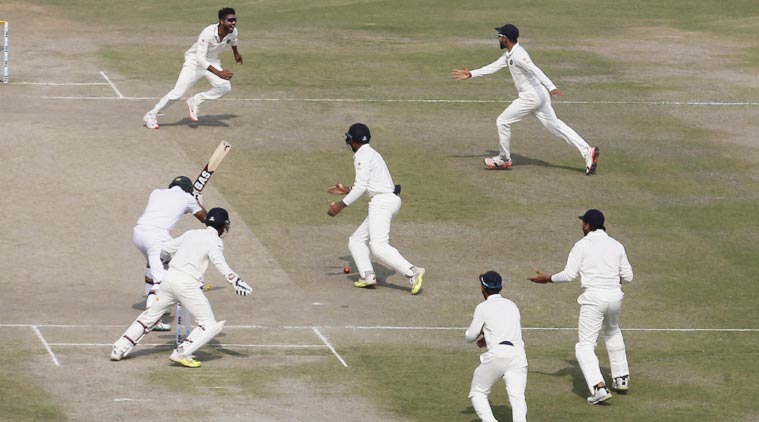 Ravindra Jadeja returned with figures of 5/21 in the second innings. (Source: Reuters)
Ravindra Jadeja returned with figures of 5/21 in the second innings. (Source: Reuters)
The last quintessential imagery of spin bewilderment in India was a close-up of Johnny Bairstow’s face. The moment started just after he was discarded by a ripper from Ravindra Jadeja that had turned past his iffy prod in a series in 2011. The dust swirled up in the haze, the close-in fielders’ feet were in the air, and celebratory shriek was just about to rush out of the crowd’s throats when the camera started to zoom in. A shifty disbelieving look to either side, the jaw fell, and he then looked up straight at Jadeja. Confusion, shock, and cluelessness etched on his pale face.
The mauling of Bairstow wasn’t a surprise. After all, he comes from a long tradition of Englishmen sinking in dustbowls of India. Who can forget the sad canine expressions of Richard Blakey in 1993 when Anil Kumble kept showing him up mercilessly with a kind of cruelty only kids seemed capable of.
Watching the Mohali Test left with two contrasting feelings — a sense of confusion about the way the batsmen, from both teams were struggling against spin and the joy of watching such a struggle on a spin track. Much has been written about the primal feeling inherent in watching a fast bowler harass a batsman. And there is indeed something to be said about watching a human terrorizing another in a controlled environment of sport. When a spinner manages to wreak similar kind of psychological damage on a batsman, even without the ability to pose any threats of bodily harm, the cerebral tease and taunt can make for a fascinating watching experience. So the whines about spin tracks are hard to understand. It can come from batsmen, losing captains, and those in the cricketing fraternity who fret about the moral ambiguity involved in creating devilish tracks, but why would a fan not like watching this disrobing of a batsman’s ego?
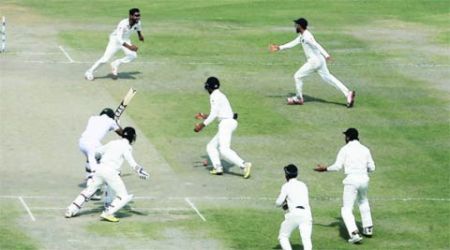 India vs South Africa: Forgotten art of playing spin
India vs South Africa: Forgotten art of playing spin India spin yarn, South Africa fall for it
India spin yarn, South Africa fall for it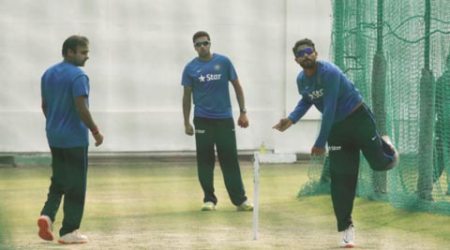 Ravindra Jadeja's dip, flight and return
Ravindra Jadeja's dip, flight and return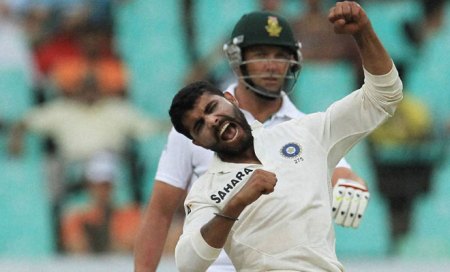 India's replacement killer: Ravindra Jadeja spins out four wickets
India's replacement killer: Ravindra Jadeja spins out four wickets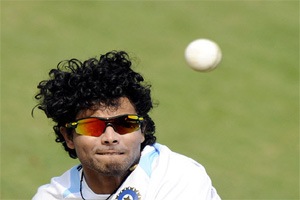 Ind vs Aus: From back-up to frontline,bowler Ravindra Jadeja whizzes ahead
Ind vs Aus: From back-up to frontline,bowler Ravindra Jadeja whizzes ahead- From back-up to frontline,bowler Jadeja whizzes ahead
But that joy is diffused when batsmen go down tamely without fight. We are then just left with this empty feeling of watching batsmen fall in a heap as if they are images from a flip book of dismissals. Like it happened in Mohali.
Playing with the turn
Especially, as the visiting batsmen have changed in character since the times of Blakey. They never quite learnt the art of sashaying down the track but found other ways. Most often than not, as seen in Jacques Kallis or Damien Martyn, or even in a lesser batsman like Neil McKenzie, it has been a simple technique — they would shuffle towards off stump and tread on the back foot, and would work everything with the turn. At times, they would even take the off stump guard . Even Ricky Ponting, who could often look all at sea on designer spin tracks, learnt not to just cope but be successful with that approach. The entire top-order would adopt such a move; it was a team plan. It was a method with which Australia eventually found success in Sri Lanka and South Africa in India. Other times, the sweep shot has been deployed though the low bounce on Mohali didn’t make it an attractive option on that surface as M Vijay found out in the first innings.
To see this South African team without a plan was slightly puzzling. It was understandable that Hashim Amla and AB de Villiers probably thought that a spontaneous approach in the middle could do it for them, for they are skilled men, but it was puzzling to see the others not have a concrete plan. For someone like Faf du Plessis, a fighter more than a natural batsman against spin, to not to have a visible plan in place did seem very odd.
The first-innings dismissals were even more stunning in its mediocrity of thought that it revealed. There were two distinct parts on that pitch – one more dark in colour and almost beginning near the feet of the batsmen which allowed for more turn and the paler one on a length onwards from where the ball was almost coming on straight. The TV replays had shown it, all the commentators too had picked it, even visuals were shown about contrasting nature of two areas, and still batsmen, equipped with video analysis, were caught escorting straight deliveries on to their stumps or on to their pads.
Indians caught in web too
Not that the Indians fared any better. To be shot out for 200-odd runs in both innings, especially when the South African spinners weren’t half as good as their own, was quite a mediocre effort. It’s difficult to pinpoint the period and year when the Indians stopped going down the track on turning tracks but it’s been a while now. It wasn’t a surprise that the two batsmen who did well — M Vijay and Cheteshwar Pujara — are the remnants of a lost art.
What was more irking was the defensive techniques of the Indians. There seems to be a fear of bat-and-pad catches that can lead to iffy defensive techniques. Instead of playing close to the body, the bat goes out alone in search of the ball, way in front of the body, which can often lead to disaster.
Someone like Mohammad Azharuddin was a master in this technique — his bat would wager out, like a stretched out torch illuminating the darkness ahead, and his wonderful wrist allowed him to turn and twist the ball into gaps. The modern batsmen are in a catch-22. They don’t have the wonderful hands that allowed Azharuddin to do what he did, nor the compactness in technique that enabled Rahul Dravid to stretch out and defend bat-and-pad together — play close to the body, basically — and nullify the spin. Someone like Sehwag hardly left the crease on a spinner’s track, but his balance in the crease was so supreme that it allowed him to flow his hands through the shots.
Praveen Amre, who was one of the last domestic batsmen who used to almost compulsively go down the track, wasn’t surprised to see how the Indian batsmen went down tamely. “They don’t have the confidence in their defence against spin. Without that confidence, you can’t go down the track or go on the back foot. The fear of being stumped or lbw makes them nervous. They are not willing to take that risk, they just play from the crease, pushing the bat around,” Amre said.
“It’s important to understand that my generation of batsmen had better quality spinners. If you just stood at the crease, those bowlers would just eat you up. You had to go forward or back, else you had no chance.” Amre, who coaches many modern-day batsmen, makes another pertinent observation: “These days the batsmen just want to train against bouncers or seaming deliveries. How many of them play against spin for long in the nets?”
If they continue to bat like this, the South Africans and the Indians are going to have many Bairstow and Blakey moments of their own. It’s not the Mohali pitch but the mediocrity of thought in the batsmen that was the real let down.





